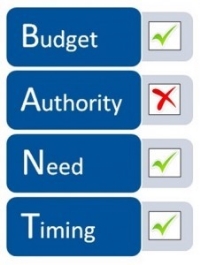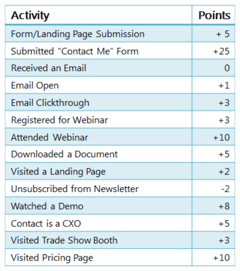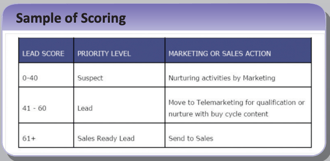
So far on this blog, we’ve talked a lot about basic marketing best practice. In the past, we’ve stressed the importance of including a Call To Action, which, simply stated, means providing your reader with a clear way to take whatever action comes next. For many of our clients, a typical call to action means filling out a lead form.
So now those Calls to Action have resulted in a bunch of inbound leads. That’s awesome. If you’re like me, you get a kick out of knowing that the message you’re putting out there is resonating with the market. So well, in fact, that folks are saying “hey, I just might be willing to give you my money.” There’s something elemental and pure about that –at least in a business sense…
But remember, marketing’s not just about making noise. For Marketing to be accountable, it must be held to the standard of ROI. Creating a basic lead scoring model is key if you want to ensure that your efforts and budget are directed at those potential customers who are most qualified to purchase.
Where to start? I always like to start with good, solid basics. The most tried and true model of lead scoring I know is called the BANT model. Used by Sales and Marketing teams everywhere, BANT is an acronym that stands for four primary qualifying factors in determining whether a lead is likely to purchase. They are:

Budget - do they have a dedicated budget for making the purchase?
Authority – are they authorized to make the final purchase decision?
Need – do they recognize that they need your offering?
Timing – are they planning to purchase within a reasonable time frame?
To be fair, BANT has its detractors. Some say it doesn’t apply to a marketing environment characterized by online interaction. True, you may not be able to gather every piece of BANT data with just a form, but we'll talk about that in a minute (two paragraphs to be exact).
Others say that BANT is incomplete and needs additional qualifiers. That’s fair. Here at Rezora we used a modified approach that includes consideration of the likely size of a potential account and some other factors. We encourage you to find a modified approach that works for you as well - but there's a thousand ways to do this (hence the phrase lead score matrix being a thing), and it can be hard to figure out where to start, so let's go over some of the basics with lead scoring.
Determining what data is vital to identifying a valuable lead is the very first step. We've already decided there's a plethora of data that could be collected, but just because you can, doesn't necessarily mean you should. The more meaningful the data, the more meaningful the lead score. To help break up the overwhelming amount of data you could potentially collect, we can create two categories: explicit data and implicit data.
Explicit data is data that your audience is explicitly giving you, usually via a lead form. This can look like name, email, company, title, location, purchase authority, etc. This type of data is best taken at face value and doesn't require any analyzing or deeper research. Implicit data is the data that you're not receiving straight from the source and does require some level of analytics. Typical implicit data might be things like website visits, email opens/clicks, webinar attendance, etc. There's also negative implicit data: data that insinuates that your target isn't ready to buy or even qualified to buy. This might look like lack of email opens/clicks, email unsubscribes, or visits to certain pages on your site (such as the Careers page). A solid rule of thumb is to pick no less than 5 and no more than 10 data points to focus on (quality over quantity!). Once you've determined which data is going to provide the most value to your lead score, you'll want to assign a score to each piece of data. This score is usually between -10 and 10; -10 being for negative implicit data and 10 being for positive implicit data. Act-On shares these examples of data points (activities) and their corresponding score:

Once each data point has a score, you'll be able to determine the highest possible lead score, though it's unlikely anyone will ever be the perfect target and end up with every point possible. This is why it's important to determine a baseline for what is considered a "cold lead", "warm lead", or "hot lead". (PS: in rezora, you can use our new beta contact management interface to mark each contact with the corresponding status of inactive, active or hot!). Marketo recommends a baseline that looks something like this:

As a real estate agent, you're essentially the marketer and the salesperson, so you can adjust the "Marketing or Sales Action" to go from generalized marketing to targeted/personalized marketing to picking up the phone and giving your lead a call - or whatever workflow is tried and true for you!
While developing a lead scoring model can take some fine-tuning, it's incredibly helpful when prioritizing leads and streamlining your workflow. The good news is, though, that Lead Scoring is one of the most heavily blogged, posted and discussed topics out there. So if you're still feeling a little stuck, here are some great additional resources:
• Act-On
• Marketo
• Hubspot
And remember that we're always here to help point you in the right direction, too! Feel free to email support@rezora.com with any questions you might have, or if you just want to say hi and talk about your day.



